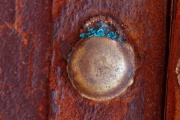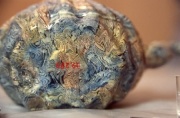Difference between revisions of "Organic acid"
Jump to navigation
Jump to search
(username removed) |
|||
| (3 intermediate revisions by 2 users not shown) | |||
| Line 2: | Line 2: | ||
== Description == | == Description == | ||
| − | A broad class of non-mineral acids that include [ | + | A broad class of non-mineral acids that include [[formic%20acid|formic]], [[acetic%20acid|acetic]], [[lactic%20acid|lactic]], [[oxalic%20acid|oxalic]], [[citric%20acid|citric]], [[stearic%20acid|stearic]], and [[tannic%20acid|tannic]] acids. Organic acids occur naturally in plants, fruits, animals, and microorganisms. They are much weaker proton donors than mineral acids, but can still have detrimental effects on materials, such as paper, leather, metals, and photographs. Of concern in a museum environment is the volatility of many of organic acids and their ubiquitous presence in many materials. |
[[File:Image3_802331.jpg|thumb|Complex organic acid salts]] | [[File:Image3_802331.jpg|thumb|Complex organic acid salts]] | ||
| Line 9: | Line 9: | ||
carboxylic acid | carboxylic acid | ||
| − | == | + | ==Resources and Citations== |
| − | P.Hatchfield, ''Pollutants in the Museum Environment'', Archetype Press, London, 2002. | + | * P.Hatchfield, ''Pollutants in the Museum Environment'', Archetype Press, London, 2002. |
| − | + | * R. J. Gettens, G.L. Stout, ''Painting Materials, A Short Encyclopaedia'', Dover Publications, New York, 1966 | |
| − | * | + | * G.S.Brady, ''Materials Handbook'', McGraw-Hill Book Co., New York, 1971 Comment: p. 313 |
| − | * | + | * Richard S. Lewis, ''Hawley's Condensed Chemical Dictionary'', Van Nostrand Reinhold, New York, 10th ed., 1993 |
| − | * | + | * Matt Roberts, Don Etherington, ''Bookbinding and the Conservation of Books: a Dictionary of Descriptive Terminology'', U.S. Government Printing Office, Washington DC, 1982 |
| − | * | + | * Random House, ''Webster's Encyclopedic Unabridged Dictionary of the English Language'', Grammercy Book, New York, 1997 |
| − | |||
| − | |||
[[Category:Materials database]] | [[Category:Materials database]] | ||
Revision as of 14:16, 26 July 2022
Description
A broad class of non-mineral acids that include formic, acetic, lactic, oxalic, citric, stearic, and tannic acids. Organic acids occur naturally in plants, fruits, animals, and microorganisms. They are much weaker proton donors than mineral acids, but can still have detrimental effects on materials, such as paper, leather, metals, and photographs. Of concern in a museum environment is the volatility of many of organic acids and their ubiquitous presence in many materials.
Synonyms and Related Terms
carboxylic acid
Resources and Citations
- P.Hatchfield, Pollutants in the Museum Environment, Archetype Press, London, 2002.
- R. J. Gettens, G.L. Stout, Painting Materials, A Short Encyclopaedia, Dover Publications, New York, 1966
- G.S.Brady, Materials Handbook, McGraw-Hill Book Co., New York, 1971 Comment: p. 313
- Richard S. Lewis, Hawley's Condensed Chemical Dictionary, Van Nostrand Reinhold, New York, 10th ed., 1993
- Matt Roberts, Don Etherington, Bookbinding and the Conservation of Books: a Dictionary of Descriptive Terminology, U.S. Government Printing Office, Washington DC, 1982
- Random House, Webster's Encyclopedic Unabridged Dictionary of the English Language, Grammercy Book, New York, 1997

